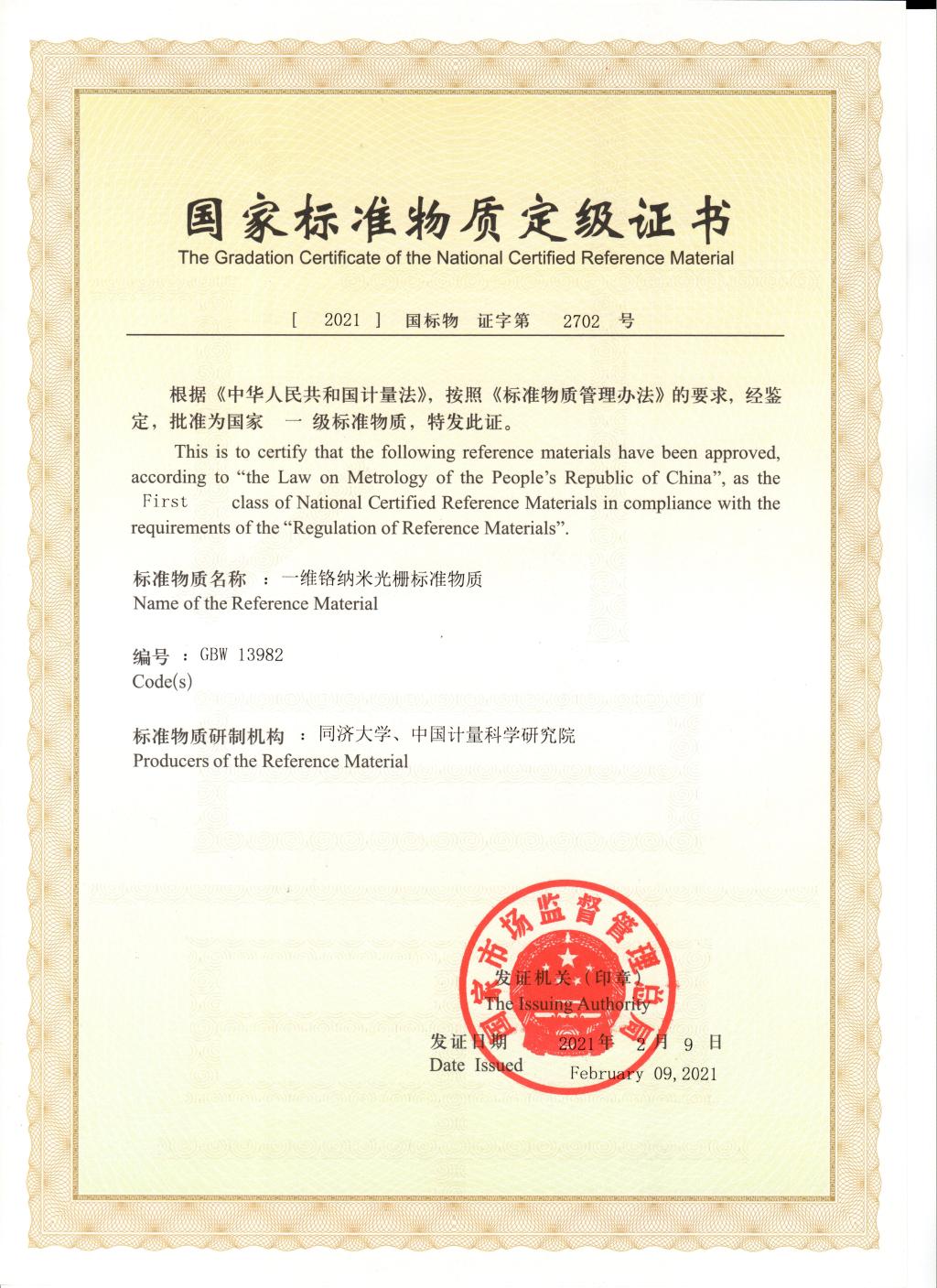Recently, the State Administration for Market Regulation officially approved two ultra-precision nano gratings jointly developed by Tongji University, the National Institute of Metrology, China and the Shanghai Institute of Applied Physics, Chinese Academy of Sciences to become the First-class of National Certified Reference Materials. The specific name is: one is the One-dimensional Chromium Nanograting Reference Material, with a grating pitch of 212.8nm ± 1.1nm (k=2), GBW13982; The second is the One-dimensional Silicon Nanograting Reference Material, with a grating pitch of 106.4nm ± 0.7nm (k=2), GBW13983. The above reference materials fill the gap in China's certified grating reference materials below 300nm scale, providing support for China's independent traceability in nano-length measurement.



Reference materials are metrological standard instruments managed by the state in accordance with the law. As highly uniform, stable, and accurate measurement standards, they have the basic functions of repeatability, preservation, and quantity transfer. Ultra-precision gratings are key components in fields such as precision displacement measurement, calibration of micro/nano processing and detection equipment, and development of high-end instruments. Relying on the Key Laboratory of Advanced Microstructural Materials of the Ministry of Education at the School of Physical Science and Engineering of Tongji University, Academician Li Tongbao's team has been the first in China to develop ultra-precision gratings that can be traced back to natural constants using atomic lithography technology since 2002. The chromium gratings with a pitch of 212.8nm have multi-scale (from 100 nanometers to millimeters) uniformity. At the same time, the research team proposed a new frequency doubling method of ultra-precision grating based on "Atomic Lithography + Soft X-ray Interference Lithography" for the first time in the world, and developed a silicon grating with a pitch of 106.4 nm in cooperation with the research team of Tai Renzhong of Shanghai Synchrotron Radiation Facility. The above two types of ultra-precision gratings have undergone a one-year uniformity and stability inspection by the nanometrology team of the National Institute of Metrology, China. The metrological calibration that can be traced back to the definition of "meter" indicate that the key parameters of the grating are stable and reliable, and the quality reaches a practical level. They can be used for the calibration of various nano measuring instruments and precision displacement measurement, providing basic support for the development of semiconductor, optoelectronics, artificial intelligence and other fields.
Quantization of measurement units and flattening of quantity value transfer are the development trends of international metrology science. In the key special project of the Ministry of Science and Technology on "Research and Application of Common Technologies for National Quality Foundations", it is clear to carry out the research task of "high-precision reference materials and flattening the transfer of quantity values" in the task chain, The national key research and development project "Research on Key Technologies of Nanoscale Photolithography Calibration Grating Standards and Development of Metrological Standards" (project number: 2019YFF0216400), led by Academician Li Tongbao from our university, is an important component of this research task. The two national first-class grating reference materials approved by our school this time, the grating pitch that can be directly traced back to the chromium transition frequency, with high accuracy, uniformity, and consistency, and possess self-traceable characteristics. In 2019, verification by the Physikalisch-Technische Bundesanstalt (PTB), German showed that the accuracy, uniformity, and consistency of the two types of self-traceable gratings can reach the pico-meter level, possessing the natural advantage of being used as length standards without the need for calibration. At present, the project team is conducting research on calibration of measurement and processing instruments, precision displacement measurement, and natural constant comparison based on self-traceable gratings, and actively promoting demonstration applications in the optoelectronics and microelectronics industries. (Text/Chen Jie; Image/Deng Xiao)
